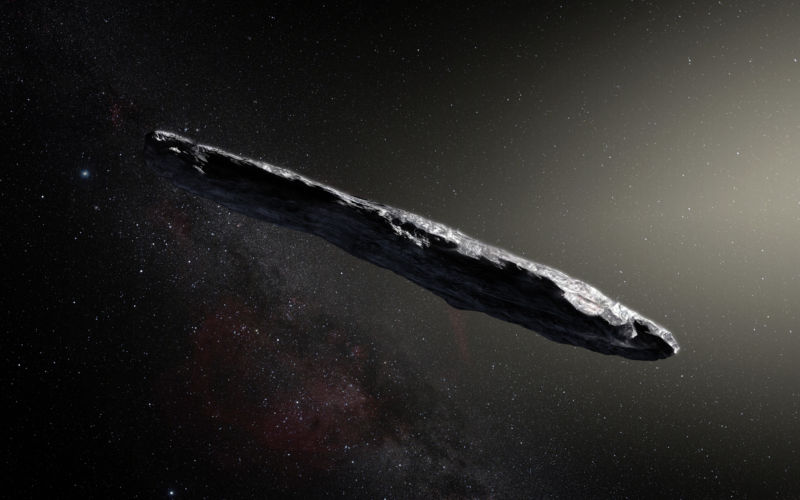Online media predictably broke off about Oumuamua and Harvard scientists
- Transfer
"Scientists do not hesitate to publish absurd ideas"

How an artist imagines a strange-shaped interstellar asteroid 1I / Oumuamua
A few days ago a preprint of research work appeared in the network , which was intended for publication in the Astrophysical Journal. The paper describes an unusual object known as Oumuamua , found at the end of 2017 - the first of the interstellar objects found in the solar system.
Scientists are still not sure what a strange-shaped cigar-shaped object is, and they were even more surprised to learn that it is accelerating as it moves away from the Sun. Based on the analysis of data from several telescopes aimed at this object, scientists found out that Oumuamua accelerates when moving from the Sun much more than can be explained by the effect of gravity alone. Unfortunately, scientists did not have a good explanation for this acceleration.
The new paper explores the possibility of pressure caused by the radiation of the sun, or the transfer of momentum from photons hitting the object. This radiation pressure is the basis of the idea of a “solar sail,” which someday may become the engine of a spacecraft exploring the Solar System or going beyond its limits.
Much of the research done by Schmuel Bayeli and Abraham Lowb of Harvard University is devoted to discussing the shape and mass of an object on which radiation pressure can have a sufficient effect to explain Oumuamua's movement and the nature of the associated natural processes. But at the end of their work, the authors suggested a “more exotic scenario”, according to which Oumuamua could be “a working probe, specially sent to the alien Earth near civilization”.
Cat mint
And some media have seized on this last line from the article. Statements of this kind, especially those emanating from such a source as Harvard scientists, attract editors of online publications, like catnip, with their ability to use words like "mysterious cigar-shaped object", "aliens" and "Harvard scientists" in one heading.
As a result, we are faced with a huge number of hypertrophied articles. NBC News reports: "Scientists say that the mysterious object of Oumuamua may be an alien spacecraft." Fox News: "A mysterious interstellar object can be a sun sail sent by another civilization." CNN: "The work of Harvard scientists argues that a cigar-shaped interstellar object could be an alien probe." It is enough to google "'Oumuamua",
This, of course, quite sloppy coverage of events. But in this case most articles are written not by trained authors specializing in science, but by online reporters who have noticed the potential of a bright headline. And although this is not “false news,” it is still a classic click trap.
But there is something else. Katie Mack, an astrophysicist and amateur commentator on the actions of scientists and the media, noted on her Twitter account that Harvard scientists understood perfectly well what they were doing. “You need to understand that scientists are not shy about publishing ridiculous ideas, if there is any chance that they will be right,” she writes. “But until all the other possibilities are exhausted many times, even the authors themselves probably will not believe in it.”
“Some scientists are more conservative than others,” she continues. - And it all depends on the field of research. But in my field (astrophysics and cosmology) there are usually no obstacles to publishing something a) interesting enough and b) not completely ruled out because of the impossibility, regardless of whether this is the “correct answer” or not ” .
In other words, a researcher who wants to generate a wave of articles in the media can play the card "I, of course, do not claim that they are aliens ..."
